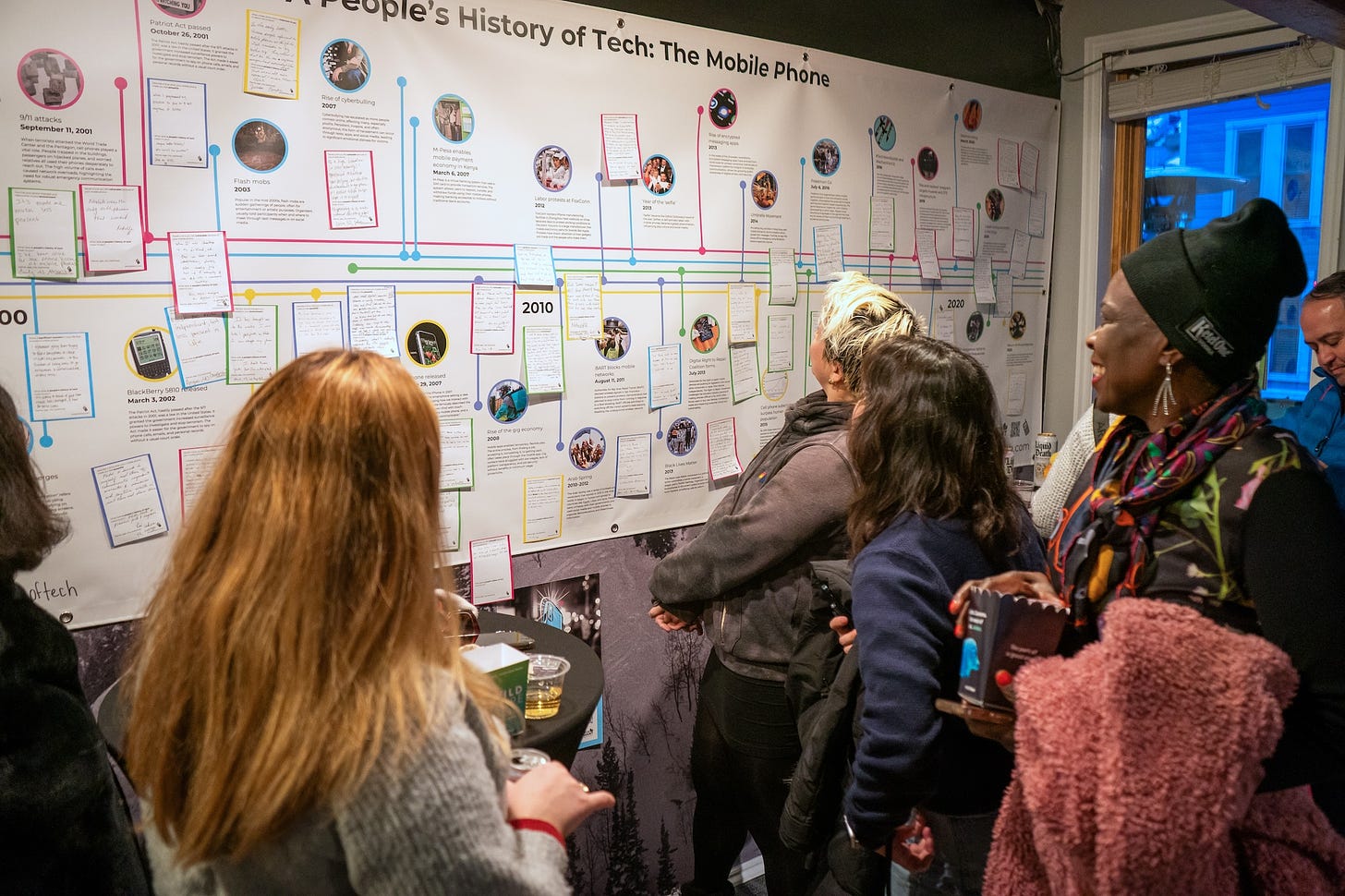Old phone history, who dis?
The digital experience of A People’s History of Tech is live! We launched the website while at Sundance and we’re only now catching our breath (blame the altitude...and the migration away from Substack) to share the news!
From the first car phone call to flashmob to mobile banking and movement mobilization, we explore the human impacts of technology, putting people at the center. Rather than focus on the lone genius founders or tech-centric innovation milestones, A People’s History of Tech shifts the focus back to the people. We’re more than users and consumers—we are citizens reinserting ourselves into the recent history of tech so we can find our agency and power in our relationship with technology.
With your submissions and input, we’ve built a storytelling scaffolding to inspire you to share your personal histories and experiences to rewrite a more inclusive tech history. Navigate through A People’s History by themes, respond to prompts that inspire you, and take action to imagine the tech we want going forward.
A People’s History of Tech at Sundance
Along with our partners and funders at The Tech We Want we explored tech history, participatory documentary storytelling, and narrative change at Sundance. We heard from inspiring indie storytellers, funders, and innovators across three days of programming at the WaterBear Impact Storyhouse and the Caspian Impact Lounge. Here’s our Sundance rundown:
🌐 launched the digital experience of peoplestech.com with our incredible design and dev team at Fly Media Productions and Flagrant
🗓️ installed a twelve foot long participatory timeline
🤳🏽 collected over 75+ personal stories for the timeline
🎤 hosted and participated in five panels over four days
🪩 danced it out to our cellphone inspired playlist

But that’s just the splashy stuff. It was the intimate, personal stories that made Sundance special:
- Rochelle remembering how Nextel was the only network that worked when she emerged from the Canal Street subway on 9/11.
- Pamela describing "mobile trees" in the interior of Suriname that folks bang on to send a rescue signal when they get lost.
- Ligaya pulling up the translation from an indigenous protest sign "You will drink lithium, you will eat copper" from posters she saw throughout Chilean mining towns.
- Tina recalled carrying a shoulder phone while on location in Australia at a time when few women were conducting mobile business.
All these stories, interspersed with the tactile joy and nostalgia of recalling our first phones (BlackBerries, and Sidekicks, and RAZRS, oh my!) are what made Sundance and A People's History of Tech presence among impact storytellers so special.
Huge thank you to our fearless leader Aniyia L. Williams for supporting this work and giving us room to explore narrative change in so many different forms to build The Tech We Want. And a huge shoutout to Emily Best for initiating us into the world of independent film making and narrative change for impact with her most thoughtful and inspiring panels and curation!
About the build
So many folks contributed to shaping this project through early workshops, interviews, and brainstorming sessions as we build in public. Some of their stories are already featured in the digital experience, with many more to come.
And a history of mobile phones is only the beginning! We developed the digital experience for this first chapter of A People's History of Tech with many other chapters and iterations in mind.
The site is an Open Culture Project and is licensed under the Creative Commons CC BY-NC-SA 4.0 (Attribution-NonCommercial-ShareAlike 4.0) International License. And the software is licensed under The Hippocratic License (HL3-FULL); created by the Organization for Ethical Source in partnership with Corporate Accountability Lab and is available on Github.
Our fantastic design and build team at Fly Media Productions and Flagrant were instrumental in getting this first chapter off the ground and into your devices. They rallied together across four time zones in a really tight turnaround while keeping our mobile-first and accessible-first priorities front and center. Here are some stats Fly Duo shared from the design and development team that reflect the ethos of A People’s History of Tech:
- At least 25% of the team is disabled.
- At least 50% of the team are women.
- At least 40% of the team are members of the LGBTQIA+ community.
- At least 37% of the team are folks who identify as BIPOC.
- At least 75% of the team are seasoned practitioners with at least a decade of experience in their craft, and the majority have 20+ years experience in the industry.
That’s what a more inclusive tech collaboration looks like. We can’t wait for you to make your mark in this participatory history.

Coming up
We’re heading your way soon!
- We’re workshopping the timeline as a facilitation tool with Stanford D School designers February 22 and scheming what histories we’ll tackle next after the mobile phone…
- We’re popping up at SXSW with our partners at Omidyar Network and The Tech We Want in March. Stay tuned!
And coming to a town near you? Reach out and let’s explore how we might collaborate in your communities.

